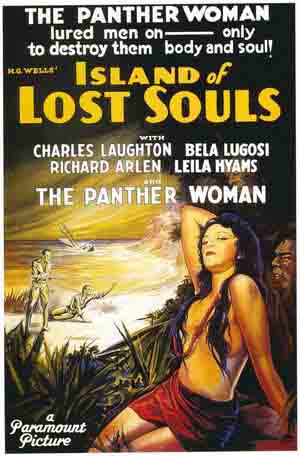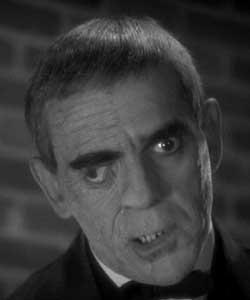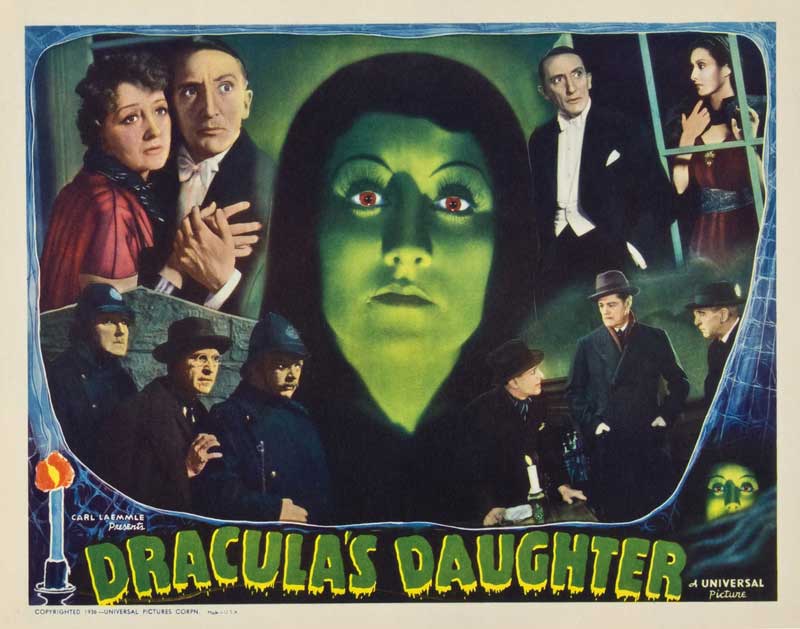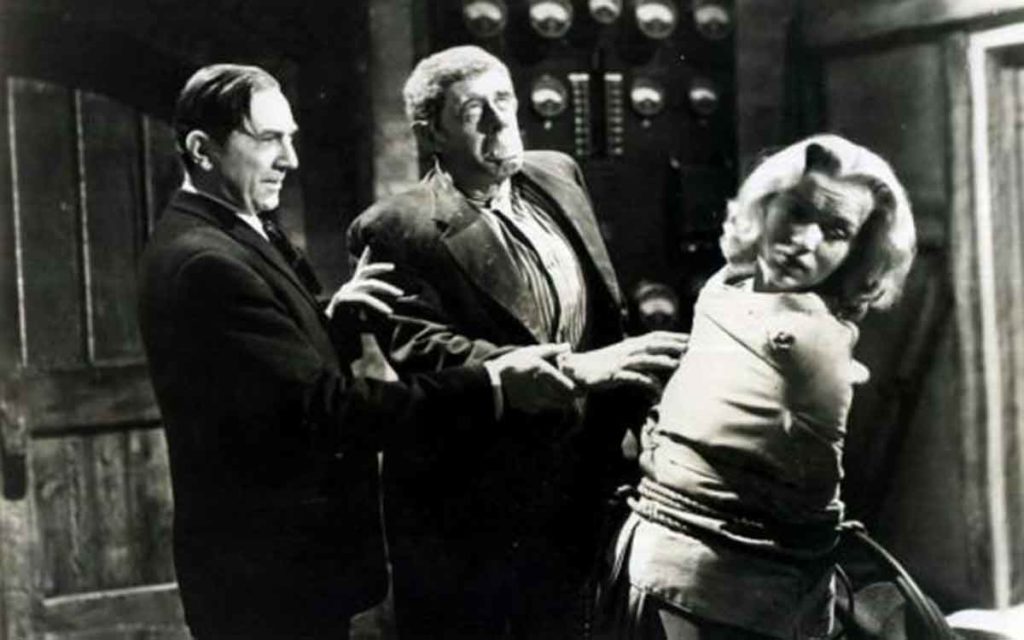JIM IVERS looks at the seemingly temporary death of horror films during the mid 1930s, the Horror Film Hiatus of 1936-1938
While researching an article on Dracula films (including the “Son of Dracula” review at this site), I stumbled across recently discovered information at The Irish Journal of Gothic and Horror Studies site that was quite remarkable. This opened up a whole new can of Anglo-American worms that I was eager to untangle and explore in depth. Expanding beyond the scope of the original Dracula piece, this became a separate addendum about censorship in the U.S. and the U.K. that should be of interest to aficionados of classic horror films.
A strange thing happened to Hollywood’s booming horror industry in the middle of 1936. All production suddenly stopped. The horror genre fell into a mysterious limbo; a self-imposed hiatus that lasted nearly three years. Then in 1939 Universal Pictures made a triumphant return with “Son of Frankenstein”. The movie was a box-office smash. The film industry then went back to cranking out horror thrillers as they had in the past — as if nothing had happened. But just what the hell did happen, anyway?
Until recently, there’s been only one standard explanation for the horror hiatus. All the trade journals and film history books claim that unreasonably harsh restrictions imposed by the British Board of Film Censors (BBFC) killed the overseas market for horror films. As the story goes, after 1935 all of Hollywood’s scary thrillers, if not banned outright, faced heavy censorship as well as the dreaded “H” (for Horrific) certificate. The “H” rating, we were told, constituted a “virtual ban” by excluding anyone under the age of 16 from theaters. These measures would have such a severely negative impact on profits that horror films were no longer viable.
The way the facts were laid out, it all make perfect sense. There’s no reason to doubt a word of it. However, the astonishing thing is that none of this is entirely true. The dire Hollywood press reports about British censorship were wildly inaccurate and exaggerated the threat to the industry. This misinformation was then ruthlessly exploited in an extraordinary Hollywood power play — a covert, single-minded campaign to put an end to horror films. And it worked, for a while anyway. Incredibly, horror films were killed in America, not overseas. Even more amazing, it was all engineered by one person, an all-powerful guardian of celluloid morality appointed by Hollywood’s moguls. He managed to pull off one of the greatest deceptions in the history of the film industry. And yet few people seem to know about it.
For all these years the truth remained buried under a mountain of flawed research. Journalists, past and present, failed to adequately investigate British censorship practices which, even today, can be perplexing and contradictory. (And don’t get me started on the notorious “video nasties” list of banned films that began in the ’80s.) However, BBFC archival records recently brought to light reveal more about what really happened during this strange interlude.
Censorship and the BBFC
Although the BBFC considered horror films problematic and wished to discourage them, the censoring of horror movies never approached a ban (or even a virtual ban via its ratings system). The BBFC generally objected to depictions of torture, disfigurement, animal cruelty, mild-to-excessive gore (“Black Sunday” banned 1960-1968), political propaganda (“Battleship Potemkin” banned until 1954), drug use (1967’s “The Trip” not shown till 2002), stories that might incite social unrest (“Rebel Without a Cause” censored, Brando’s “The Wild One” banned until 1967), cannibalism, libidinous Nazis (1969’s “Love Camp 7” still banned), zombies, improper use of city parks (“Don’t Go Near the Park” 1981, “House on the Edge of the Park” 1980, still banned), and of course, William Shatner (“Visiting Hours” 1982, and a 1968 Star Trek episode are still banned). Plus films that are simply too weird to be categorized; the public was shielded from the insane what-the-fuckery of Ed Wood’s “Glen or Glenda” (1953) until a 1995 video release.
According to “The Irish Journal of Gothic and Horror Studies” (but not confirmed by other questionable online sources), five U.S. films made before 1936 were banned outright. These are:

Freaks (MGM, 1932)
One of the most disturbing films ever made; a showcase of actual physical deformities and a finale depicting the effects of grotesque mutilation. This barely got released in the more permissive U.S. It was finally shown in the UK, with an “X” rating, in 1963.
Island of Lost Souls (Paramount, 1932)
Based on the H.G. Wells novel, the initial BBFC objection was the main theme (evolution altered by science) being “a challenge to natural law.” To this, Elsa Lanchester, wife of star Charles Laughton, quipped: “Of course it’s against nature. So’s Mickey Mouse.” Denied certification several times, partly due to “suspected animal cruelty” (even though they were actors in hairy animal makeup) until 1958.
The Monster Walks (1932)
Tepid “old dark house” murder mystery; probably “suspected animal cruelty” in regards to a highly agitated ape that jumps around and snarls in its cage.
Black Moon (Columbia, 1934)
Caribbean island voodoo cult thriller most likely suppressed for the same reason Tod Browning’s 1936 “The Witch of Timbuctoo” script was rejected. The BBFC requested the removal of all black characters from Browning’s story for fear the witchcraft scenes would “stir up trouble” among blacks under British colonial rule. The screenplay was totally revamped and produced as “The Devil-Doll” — with an all-white cast.
The Crime of Dr. Crespi (1935)
Loosely based on Poe’s “The Premature Burial”; a man is drugged and buried alive.
Trouble began, as the official story goes, with “The Raven” (1935), Universal’s nastiest Karloff/Lugosi vehicle. Lugosi plays a sadistic, Poe-obsessed surgeon with his own torture dungeon. The British censors objected to certain scenes, but the film was not banned. In fact, no Universal films were ever banned. And no horror films at all were banned in the U.K. from 1936 to 1941. The BBFC banned only two films in the forties. Both are no-budget Poverty Row B-movies. Lugosi’s “The Corpse Vanishes” (Monogram, 1942) and “The Mad Monster” (PRC, 1942) with George Zucco. These are routine, formulaic potboilers so lacking in offensive content it’s hard to determine what all the fuss was about.
Somehow, word began to spread that “The Raven” had caused enough outrage overseas to signal the end of the horror craze. An Associated Press release in 1935 even announced: “Horror Films Taboo in Britain; ‘The Raven’ Last.” However, this was entirely untrue. In 1936 three horror films, “Dracula’s Daughter” (Universal), “The Walking Dead” (Warner Bros.), and “The Devil-Doll” (MGM), were certified and released to theaters in the U.K.
“Dracula’s Daughter” was given an “A” certificate (under-sixteens allowed with a parent or guardian). The “A” rating was loosely enforced at best, and did little in practice to restrict children’s access to films. “The Walking Dead” also passed with an “A” certificate and a cut of 100 feet. “The Devil-Doll” received an “H” (Horrific) rating and a minor cut. The “H” certificate was a purely advisory label which allowed horror films to be passed with a warning, without further cutting. It did not restrict access to children. Hollywood journalists misinterpreted the H-rating as a virtual ban.
While the BBFC may have claimed to be hostile to all horror films on general principles, their treatment of them was variable and inconsistent. Throughout the 1930s, the BBFC passed some horror films uncut but bearing the “H” label, while others were passed with an “A” certificate but with cuts. “The Mummy” (Universal, 1932) passed uncut with an “A”, while “The Vampire Bat” (Majestic, 1933) was cut by 99 feet and still given an “H” label. MGM’s “Mark of the Vampire”, Universal’s “Werewolf of London” (both 1935), and “Bride of Frankenstein” (1939) were all certified “H” and all did well at the box office.
Hollywood and the Production Code
Negative press from Hollywood scandals in 1921-22 and talk of government censorship of films resulted in the major studios creating their own self-regulating agency, the Motion Picture Producers and Distributors of America (MPPDA). Led by arch-conservative Will Hays, the MPPDA was merely an advisory board with little authority or influence. In 1930 a Catholic pressure group drafted a rigid Production Code which the MPPDA was obliged to accept (but not necessarily enforce). The Code provided a detailed guideline that dictated the content of Hollywood films. Any depiction of sexual impropriety, prostitution, excessive violence, drug addiction, lawlessness without punishment, and disrespect for authority (especially the Church) was forbidden. The Code demanded that films depict “correct standards of life” and promote traditional values — in line with conservative Catholic doctrine. It was initially decided to keep the Catholic influence on the Code a secret. What resulted has been described as “a Jewish owned business selling Roman Catholic theology to Protestant America.”
Initially, the adoption of the Production Code was merely a symbolic gesture to generate positive publicity and keep the federal government from getting involved. The Code was not enforced between 1930 and 1934 (aka the pre-Code years) and was often mocked by journalists. The combination of Prohibition and a crippling Depression created a dark mood of cynicism, despair, and a general contempt for authority. This was reflected in the early sound films. Violent gangster sagas all but glorified criminality, seedy low-life melodramas bristled with racy, provocative content, and a new breed of shocking horror films offered supernatural as well as science-based thrills and chills. These were the most popular and profitable films of that era.
By 1934, the potentially harmful influence of these “immoral”, unregulated films on the public — especially children — became the subject of serious public debate. Outraged moralists and religious groups (including the newly formed Catholic Legion of Decency) petitioned for the creation of a federal censorship board to stem the tide of decadent and depraved films they saw pouring out of Hollywood. This was the tipping point that led to the MPPDA’s creation of the Production Code Administration (PCA).
Granted an unprecedented amount of power, the PCA rigorously enforced Production Code guidelines which had previously been ignored. Studios now had to submit all scripts, rewrites, and films for approval and make whatever changes or cuts the PCA demanded. In lieu of government interference, it seemed a workable solution. However, like Dr. Frankenstein, Hollywood had created a monster it could not contain. A bitter 30-year struggle for creative control between the studios and the PCA was set in motion.
Joseph Breen, a hard-nosed conservative and staunch Roman Catholic, was appointed by Will Hays as the “troubleshooter” for the PCA. (The Code is often incorrectly called the Hays Code, but he had nothing to do with it, and never enforced it; if anything, it should have been dubbed the Breen Code.) Breen despised horror films and did everything in his power — which was considerable — to discourage their production. This was part of an overall scheme to redirect the entire industry towards other “inoffensive” types of filmmaking. To Breen, horror films were as immoral and indecent as the recently-banned movies depicting prostitution and drug use. Such films, he felt, demonstrated the industry’s deplorable lack of social responsibility.

After “The Raven” was released, Breen began collecting numerous press reports which greatly overstated the restrictions on horror films in England. These reports were used to perpetuate a myth that the complex and confusing British censorship process constituted a virtual embargo on horror films. In 1935 and 1936 the Breen Office began issuing increasingly dire warnings that any horror film exported to England was bound to be flatly rejected or at least cut to pieces by the censors. Breen painted as bleak a picture as possible. In addition, he found much objectionable content in every horror-based script submitted to the PCA, miring films in long and troublesome negotiations. He constantly advised producers and studios not to make more horror films and to remove all horror content from projects in development. Little, if any, distinction was made between the requirements of the Production Code and the “political censor boards” alluded to in nearly all his letters.
The End of an Era
The first great cycle of horror cinema, which began in 1931, came to an end after the release of the last three horror films of 1936: “The Walking Dead”, “Dracula’s Daughter”, and “The Devil-Doll”. The rough treatment they received from the Breen Office illustrates how the industry was manipulated and ultimately pushed away from the horror genre.

The initial script for “Dracula’s Daughter” was rejected outright by the PCA due to “countless offensive stuff which makes the picture utterly impossible for approval”. Much “sex and horror” had to be cut out, including Dracula’s three brides from the first film. One of the early treatments contained flashbacks showing Dracula and his army of minions abducting and abusing a group of women taken to his castle. A second rewrite was also rejected and a six-page list of changes were suggested. Virtually everything Dracula did met with strong disapproval. This forced Universal to eliminate the prequel scenes with Dracula and put all the focus on the titular daughter. It was easier to get away with the “softer” killings of a female vampire. Posing as an artist, the countess puts the bite on a female model; a famous scene with strong lesbian overtones. The script had the model posing nude, but this was toned down to exposed shoulders while wearing a slip. The entire story had to be rewritten several more times to conform with Breen’s demands. Even during filming, revised pages had to be submitted daily for approval. The resulting film was smoothly produced but rather bland. The countess began as a sadistic femme fatale with masochistic male (and female) slaves and a boudoir stocked with torture devices. She ended up as a haunted, partly sympathetic character trapped by circumstances (like Larry Talbot in “The Wolf Man”) who yearns for a normal life. The film was a critical and box office success in the U.S. and abroad.
“The Walking Dead” also underwent extensive rewriting at the behest of the PCA. Breen had Warner Brothers remove all explicit detail from both the revival of the dead and a series of murders, which make up the bulk of the action. This forced the studio to rewrite the story entirely. Over the course of several rewrites, the PCA repeatedly demanded that the script be further toned down. Breen also fretted about the appearance of Karloff’s character, warning that they must not “overdo the gruesomeness.” (As mentioned earlier, the BBFC still cut 100 feet of film which was probably deemed too “gruesome” for audiences in the U.K.)
“The Devil-Doll”, directed by Tod Browning, began, as mentioned earlier, as a standard horror thriller. It was adapted from the novel “Burn Witch Burn” (1934) by A. Merritt. However, after lengthy and convoluted negotiations with the Breen Office at every stage of its making, it was heavily reworked and finally released as a fantasy-novelty film. MGM was advised against promoting it as a horror movie. After some minor cuts, the film was approved in Britain.
All three screenplays began as typical horror stories that were changed almost beyond recognition by the end. Breen’s strategy was to “cleanse” each horror script, removing the essential horror elements to the point of shifting genres. He was especially successful with “The Devil-Doll”, converting it into a novelty-thriller. After this experience, all three studios began to view the horror genre as more trouble than it was worth.
The Hiatus Period
Universal Pictures underwent a change in ownership after the release of “Dracula’s Daughter”. The new president was less inclined to do battle with the endlessly obstructive PCA. In April 1936, less than two weeks before “Variety” announced that horror films were doomed, Universal sent the PCA the synopsis of a proposed Karloff/Lugosi film, “The Human Robot” (aka “The Electric Man”). The Breen Office responded with a particularly strongly-worded warning against making a horror film, citing the usual problems with “foreign censors”. This time Universal caved in and shelved the script for five years. The new management, following the business model of 20th Century Fox, wanted to concentrate on conventional mainstream films.
In 1937 there were no attempts by any studio to put a horror film into production. In September 1938, Columbia began developing a horror film, “The Man They Could Not Hang” (first in a series of four Karloff vehicles that had essentially the same plot). Not surprisingly, the script was flatly rejected by the PCA. Breen was offended by “the excessive number of gruesome and brutal killings.” The studio received the standard warnings about “political censorship” difficulties, hinting that the BBFC would most likely reject the film. Columbia eventually agreed to change it into a murder mystery rather than a horror story with the killings left largely off-screen. Released in 1939, the film was approved by the BBFC without incident.
In March 1938, Universal was reduced to essentially asking permission from the PCA to make a sequel to “The Invisible Man” (1933). The studio was strongly cautioned, as usual, to avoid “excessively brutal or gruesome subjects”, and encouraged to make “a broad comedy with trick photography” instead. Once again the studio gave up and “The Invisible Man Returns” was shelved for over a year. A full treatment was not sent to the PCA until June 1939, six months after the release of “Son of Frankenstein”, the film that effectively ended the hiatus.
The Return of Frankenstein
In 1938 a run-down Los Angeles grindhouse theater facing bankruptcy put on a limited-run triple bill of “Frankenstein”, “Dracula”, and RKO’s “Son of Kong”. (Some sources claim the third film was “The Mummy”.) This was a surprise box-office hit. People turned out in droves to see horror features that were seven years old (ancient by movie standards). That prompted Universal to reissue “Frankenstein” and “Dracula” as a double feature which sold out theaters in major cities across the country. The popularity of horror films was undeniable. Universal decided it was time to return to horror film production starting with a sequel to 1935’s “Bride of Frankenstein”.
“Son of Frankenstein” was rushed into production with Karloff playing the monster for the third and last time. This was also the last big-budget “A” horror picture the studio would make. Some sources say it was going to be filmed in color until a disappointing test reel (now mysteriously lost) put an end to that plan. Others claim this is a misunderstanding due to color 8mm home movie footage turning up of Karloff cavorting on the set in full monster makeup. (Excerpts of the home movie film can be seen online at YouTube, etc.)
The project began with an overly talky screenplay featuring a chatty monster who goes on a savage killing spree. These elements were discarded over the course of numerous rewrites. The chaotic production was behind schedule, wildly over budget, and lacked a finished script. Once again Breen tried to prevent the film from being made, but this time his rants were ignored. Plus, with war looming on the horizon, the central debate in censorship was shifting away from the social effects of sex, violence, and horror to films with political messages and anti-Fascist propaganda. Incredibly, the Code’s directive against criticizing any government prevented several anti-Nazi films from being made until the fact-based ”Confessions of a Nazi Spy” (1939).
It seems appropriate that the lumbering Frankenstein Monster — an indestructible, unstoppable man-made creation — would walk all over the PCA and crash through the barrier of the hiatus. Released in January 1939, the movie was a huge box-office hit in the U.S. and abroad (despite the BBFC’s “H” certificate). This confirmed that horror films were still profitable overseas and that the hand-wringing of the PCA could be ignored. Universal went ahead with “The Invisible Man Returns” (1940) as a horror film, not a comedy, despite PCA interference. It was passed by the BBFC without an H certificate. In 1941 Universal dusted off “The Human Robot” script and produced it as “Man Made Monster” with Lon Chaney Jr. in his first starring role.
As mentioned earlier, in spite of endless warnings from the Breen Office about British opposition to horror films, only two movies (both from 1942) were banned in Britain between 1936 and 1950. Breen used the importance of the British market and the complexity and murkiness of its censorship practices as leverage in a personal vendetta against the horror genre. But in the end, money talked the loudest, drowning out the shrill protests of the PCA. Universal, and other Hollywood studios, went back to the business of churning out exciting — and often gruesome — horror films that audiences loved.

It’s ironic that 1939 also saw the release of the British horror shocker “The Dark Eyes of London” (U.S. title: “The Human Monster”) based on an Edgar Wallace novel. Bela Lugosi stars as the sadistic Dr. Orloff who exploits and brutally kills residents in a home for the blind. A particularly nasty and disturbing film featuring an ugly, disfigured henchman and scenes of great cruelty. (It was banned in Finland as late as 1947.) How this film — which would have given Breen fits — managed to get produced and distributed in England with only an H rating is a study in contradiction that must, for now, remain a mysterious footnote to this strange saga.
JIM IVERS is an artist, occasional writer and copy editor for publishers that have the nasty habit of going out of business. He lives in the U.S. and currently writes about genre films for “The Kobb Log”, a horror-SF-fantasy ‘zine.







